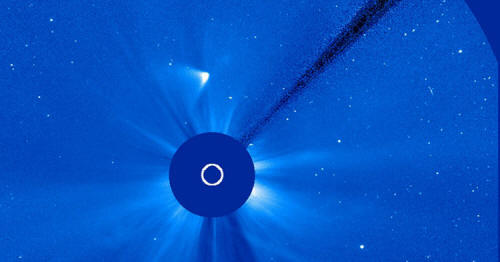|
November 29, 2013 from MPG Website
permits conclusions about
yesterday's encounter with the sun
At the time of its closest approach to the sun, comet ISON still had an active nucleus which was spewing gas and dust.
This is the assessment made by scientists at the Max Planck Institute for Solar System Research in Katlenburg- Lindau. They are currently analyzing actual pictures of the instrument LASCO which enjoys a unique view of the comet from its vantage point on board of the Solar Observatory SOHO.
From the assessments, it is not clear whether the nucleus still exists or whether it partially fragmented on its fiery swing around the sun.
The remains of ISON: On this image taken by satellite Soho, a tail-like structure is moving away from the sun.
The object is even
getting brighter.
New images from this morning now allow further conclusions.
According to Hermann Böhnhardt,
the part of the tail that is pointing towards the sun consists of
dust particles, which were released significantly before the comet's
Perihelion passage - i.e. prior to reaching the closest point to the
sun.
Only the LASCO images from tomorrow, Saturday, will allow an analysis of whether a nucleus exists.
The dust that ISON may release today
needs a few hours to make its way into the visible tail region,
where it can be detected. Whether the comet nucleus was still intact
at Perihelion or continued its flight as a small fragment or as
collection of chunks is not yet clear.
From this, researchers can draw conclusions about the elements and molecules in the comet's dust cloud.
Exact results of the measurement,
however, are not yet available.
|

